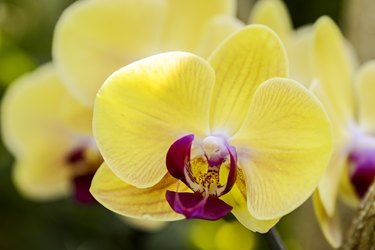
Orchids (Orchidaceae) are the largest family of flowering plants on earth. You may observe a common problem, though: the orchid spike turning yellow or orchid stem turning yellow. Orchids grow in two primary forms: monopodial and sympodial. Monopodial orchids have aerial roots, and the leaves grow from the stem ends with flowers on the sides at the leaf bases. Sympodial orchids are more common, and grow laterally with bulb-like stems called "pseudobulbs." This type of orchid flowers from the pseudobulb end. Most orchids grow in USDA hardiness zones 6 to 9, although half-hardy orchids grow only in USDA zone 11.
Orchid Stem Turning Yellow
Video of the Day
Orchids are not the easiest plants to care for, but these stunning flowers are very popular. There are approximately 20,000 to 30,000 species in the world. The main concern about orchids is when their stems turn yellow. Since these plants do not have a lot of stems and flowers, the thought of cutting the yellowed stems could be of concern.
Video of the Day
Yellow orchid stems can develop when the plants get too much direct light or the flower spike is dying. The stems can also turn red, pink or brown, but if they turn black, it can be a sign of a fungal infection. Withered, yellow stems will not produce flowers, so they should be cut. This will redirect the orchid's energy toward root growth and development.
Caring for Orchids
Keep indoor orchids by south- and east-facing windows for the most success. Make sure that the leaves do not touch the glass since window panes are known to freeze in cold climates. You can reposition the orchids when the seasons change, taking care that they do not get too much sunlight. Some light shade from blinds or a sheer curtain is also optimal.
Orchids can also get viruses, and if left unattended, the plant can perish. Prevention is the best way to avoid orchid viruses, so be sure to sterilize your tools before doing any cutting or pruning. Try using a disposable razor blade that has been cleaned in isopropyl alcohol.
Other Orchid Ailments
There are several other orchid ailments that can be treated by home gardeners to varying effects. They can develop not just yellow stems but yellow leaves, usually due to overwatering, which can damage the roots. You can try taking the orchid out of its pot (very gently) to look at the roots.
If they appear soggy, cut back on the watering and remove any yellow, dead leaves. If the orchid has aerial roots that look shriveled, try increasing the humidity. Be conservative with this, as dried-out aerial orchid roots do not necessarily indicate a problem.
A lack of water or humidity can lead to brown-tipped leaves; in this case, try putting the plant on a pebble tray. Clean the tray every two months, using a 10-percent bleach solution. Or, first try watering the orchid a bit more often. Black spots can be more problematic if they enlarge and appear mushy. Use the sterilized razor blade to cut off those sections; you can then dust the wounds with a bit of cinnamon, which is a natural fungicide. If the black spots are tiny and look like speckles, don't worry because that is a reaction to water hitting the plant's leaves.